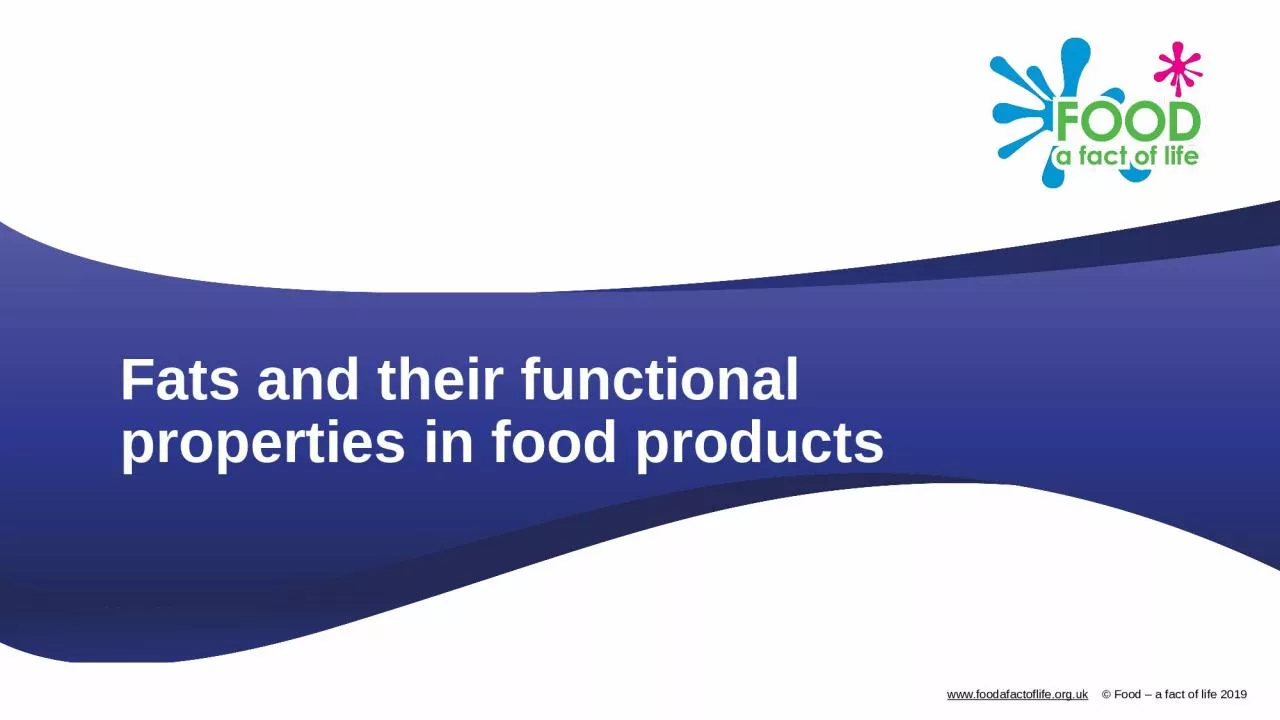

properties in food products Fatty a cids Fats are composed of fatty acids and glycerol A fatty acid is made up of a chain of carbon atoms with a methyl group at one end and an acid group at the ID: 917749
Download Presentation The PPT/PDF document "Fats and their functional" is the property of its rightful owner. Permission is granted to download and print the materials on this web site for personal, non-commercial use only, and to display it on your personal computer provided you do not modify the materials and that you retain all copyright notices contained in the materials. By downloading content from our website, you accept the terms of this agreement.
Slide1
Fats
and
their
functional
properties in food products
Slide2Fatty a
cids
Fats are composed of fatty acids and glycerol. A fatty acid is made up of a chain of carbon atoms, with a methyl group at one end and an acid group at the other. Each carbon atom in between has either one or two hydrogen atoms bonded to it.
Slide3Fats
At one end of the carbon chain is the acid group which is able to
bond with the glycerol molecule.Three fatty acids combine with one molecule of glycerol to form a triglyceride.The fat found in food is made up of triglycerides.
Slide4Saturated or unsaturated
fatty acids
If the fatty acid has all the hydrogen atoms it can hold, it is said to be saturated.However, if some of the hydrogen atoms are missing and have been replaced by one or more double bonds between the carbon atoms, then the fatty acid is said to be unsaturated.
Slide5Mono and polyunsaturated fatty acids
If there is one double bond the fatty acid is known as a monounsaturated fatty acid
.If there is more than one double bond then the fatty acid is known as a polyunsaturated fatty acid.
Slide6Saturated
fats
The nature of a fat depends upon the types of fatty acids which make up the triglycerides. All fats contain both saturated and unsaturated fatty acids, but are usually described as ‘saturated’ or ‘unsaturated’ according to the proportions of fatty acids present. For example, butter is often described as a ‘saturated’ fat because it has more saturated fatty acids than unsaturated fatty acids, while most vegetable oils are described as ‘unsaturated’ as they
contain
more monounsaturated or polyunsaturated fatty acids.
Slide7Unsaturated
fats
Most ‘unsaturated fats’ are liquid at room temperature, are usually of vegetable origin and are commonly known as oils. Vegetable and fish oils can be ‘hardened’ by a process which adds hydrogen atoms to some of the double bonds in the unsaturated fatty acids. This process is known
as ‘hydrogenation’.
Hydrogenated vegetable
oils are occasionally used in the manufacture of
soft spreads
and cooking fats, which may be used to produce cakes, biscuits and other bakery products
.
Slide8Partially hydrogenated vegetable oils
Partially hydrogenating vegetable oils may pose health risks, as this method can produce harmful
trans fatty acids. Manufacturers can use either complete hydrogenation or other novel processes to solidify these oils.This has drastically reduced the levels of trans fats consumed from the resulting products.In the UK,
hydrogenation of any kind
is now
very rare. Many products instead use
palm
oil, which contains a lot of saturated fatty acids, making the product solid.
Slide9Rancidity
When fats spoil, they become rancid.
Rancidity is often caused by the process of oxidation, which in this case refers to a reaction between unsaturated fatty acids and the oxygen in the air. The reaction is accelerated by heat, light and the presence of trace metals. It causes discolouration and the development of ‘off’ flavours.
Slide10Shortening
Shortcrust pastry, biscuits and shortbread rely on fat to give them their characteristic crumbly texture.
The fat coats the flour particles and prevents them from absorbing water. This reduces the gluten development, which would cause the dough to become elastic.
Fats
such as pure vegetable fats or lard are suitable for shortening because of their low water content.
There
are distinctive colours associated with the type of fat used.
Butter produces a
golden colour and lard produces a pale yellow.
A
compromise is sometimes reached by using a combination of the two.
Slide11Plasticity
Fats do not melt at fixed temperatures, but over a range.
This property is called plasticity. It gives all fats unique characteristics. This plasticity is due to the mixture of triglycerides, each with their own melting
point.
Some
products are formulated
using
fats
containing triglycerides with lower melting points so
they can spread from the
fridge (e.g
.
soft spread)
or melt on the
tongue (e.g
.
chocolate).
Other
fats have
higher melting points and
are used for cooking.
Slide12Aeration
Products such as creamed cakes need air incorporated into the mixture in order to give a
well-risen texture. This is achieved by creaming a fat, such as butter or baking spread, with caster sugar.Small bubbles of air are incorporated and form a stable foam.
Slide13Flakiness
Flaky and puff pastry use fat to help separate layers of gluten and starch formed in the dough.
The fat melts during cooking, leaving thin layers. The water present in the pastry produces steam, which evaporates and causes the layers to rise. The fat prevents the layers from sticking together.
Slide14Retention of
moisture
Some fats can help retain a bakery product’s moisture and increase its shelf-life. They may also be used to baste food that is being cooked by dry heat.
Slide15Glazing
Placed on hot vegetables, some fats, e.g.
butter, give a glossy appearance.Fats also add shine to sauces.
Slide16Sensory
attributes
All fats and oils have unique flavours and odours. Some are more suited for particular purposes than others, e.g. olive oil for salad dressing (for flavour) and lard for pastry (due to its blandness). They can also contribute to the texture of the food, for example by increasing succulence.
Slide17Fats
and their
functional properties in food products For further information, go to:www.foodafactoflife.org.uk